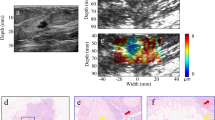Abstract
Background: Interstitial fluid pressure (IFP) in rodent malignant tumors is reportedly much higher than in surrounding normal tissue. We hypothesized the same may be true in human invasive breast tumors.
Methods: We measured IFP in the operating room in 25 patients undergoing excision breast biopsy under local anesthetic for diagnostic purposes.
Results: In patients with invasive ductal carcinomas IFP was 29 ± 3 (SE) mm Hg, compared with −0.3 ± 0.1 mm Hg in those with normal breast parenchyma (p < 0.001), 3.6 ± 0.8 mm Hg in those with benign tumors (p < 0.003), −0.3 ± 0.2 mm Hg in those with noninvasive carcinomas (p = 0.034), and 0.4 ± 0.4 mm Hg in those with other benign breast conditions (p = 0.002). There was a direct correlation between IFP and tumor size (R2 = 0.3977; p = 0.021). No correlation was found between IFP and nuclear grade, angiolymphatic invasion, systemic blood pressure, metastasis to lymph nodes, or estrogen and progesterone receptors.
Conclusions: IFP measurements may facilitate radiographic or ultrasound localization of small or nonpalpable malignant tumors in those patients undergoing needle aspiration cytology or stereotactic core needle biopsy.
Similar content being viewed by others
References
1._Jain RK. Transport of molecules across tumor vasculature.Cancer Met Rev 1987;6(4):559–93.
2._Peterson HI. The microcirculation of tumors. In: Orr FW, Buchanan MR, Weiss L, eds.Microcirculation in cancer metastases. Ann Arbor, MI: CRC Press, 1991:277–98.
3._Senger DR, Galli SJ, Dvorak AM, Peruzzi CA, Harvey VS, Dvorak HF. Tumor cells secrete a vascular permeability factor that promotes accumulation of ascites fluid.Science 1983;219:983–5.
4._Jain RK. Transport of molecules in the tumor interstitium: a review.Cancer Res 1987;47:3039–51.
5._Weiss L, Haydock K, Pickren JW, Lane WW. Organ vascularity and metastatic frequency.Am J Pathol 1980;101:101–14.
6._Young JS, Lumsden CE, Stalker AL. The significance of the “tissue pressure” of normal testicular and of neoplastic (Brown-Pearce carcinoma) tissue in the rabbit.J Pathol Bacteriol 1950;62:313–32.
7._Gullino PM, Clark SH, Grantham FH. The interstitial fluid of solid tumors.Cancer Res 1964;24:780–97.
8._Boucher Y, Kirkwood JM, Opacic D, Desantis M, Jain RK. Interstitial hypertension in superficial metastatic melanomas in humans.Cancer Res 1991;51:6691–4.
9._Gutmann R, Leunig M, Feyh J, Goelz AE, Messmer K, Kastenbauer E, Jain RK. Interstitial hypertension in head and neck tumors in patients: correlation with tumor size.Cancer Res 1992; 52:1993–5.
10._Roh HD, Boucher Y, Kalnicki S, Buchsbaum R, Bloomer WD, Jain RK. Interstitial hypertension in carcinoma of the uterine cervix in patients: possible correlation with tumor oxygenation and radiation response.Cancer Res 1991;51:6695–8.
11._Boucher Y, Baxter LT, Jain RK. Interstitial pressure gradients in tissue-isolated and subcutaneous tumors: implications for therapy.Cancer Res 1990;50:4478–84.
12._Less JR, Posner MC, Boucher Y, Borochovitz D, Wolmark N, Jain RK. Interstitial hypertension in human breast and colorectal tumors.Cancer Res 1992;52:6371–4.
13._Jain RK. Delivery of novel therapeutic agents in tumors: physiological barriers and strategies.J Natl Cancer Inst 1989; 81:570–6.
14._Donegan WL. Evaluation of a palpable breast mass.N Engl J Med 1992;327(13):937–42.
15._Hollander M, Wolfe D. Distribution free rank sum test (Wilcoxon) and distribution free test (Kruskal-Wallis). In: Hollander M, Wolfe D, eds.Nonparametric statisticalmethods. New York: Wiley, 1973:68–74, 115-9.
16._Draper NR, Smith Draper H. Fitting a straight line by least squares. In: Draper NR, Smith Draper H, Richard N, eds.Applied regression analysis, 2nd ed. New York: Wiley, 1981:1–70.
17._Liotta LA, Stetler-Stevenson WG. Principles of molecular cell biology of cancer: cancer metastasis. In: Devita VT, Hellman S, Rosenberg SA, eds.Cancer: principles and practice ofoncology. 3rd ed. Philadelphia: J. B. Lippincott, 1989:98–115.
18._Sugarbaker EV. Patterns of metastasis in human malignancies.Cancer Biol Rev 1981;2:235–78.
19._Ewing T. In:A treatise on tumors. Philadelphia: WB Saunders, 1928.
20._Nathanson SD, Putnam M. Metastasis to regional lymph nodes: the influence of lymphatic flow rates.Clin and Exp Metastasis 1990;8:71–2.
21._Folkman J, Klagsbrun M. Angiogenic factors.Science 1987;235:442–7.
Author information
Authors and Affiliations
Rights and permissions
About this article
Cite this article
Nathanson, S.D., Nelson, L. Interstitial fluid pressure in breast cancer, benign breast conditions, and breast parenchyma. Annals of Surgical Oncology 1, 333–338 (1994). https://doi.org/10.1007/BF03187139
Received:
Accepted:
Issue Date:
DOI: https://doi.org/10.1007/BF03187139




